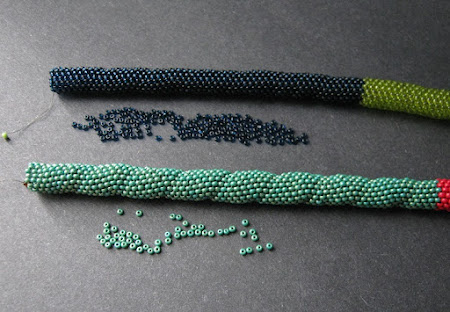I decided it was time to compare some of the major seed bead brands, and track some of the variables that make them preferable to each beader. This would not be a competition - the purpose is not to see which brand is ‘better’, but to see what separates them all from each other. There are many factors that go into choosing the right seed bead, and so long as the quality of glass is good, properties such as price, color, colorfastness, and availability usually win out.
I started by selecting two colors and finishes from each of the brands I use in my designs: Toho, Miyuki, Matsuno, and Preciosa. I did not include Delicas, because although they are technically seed beads, they don’t have the same properties as round seed beads or rocailles. I briefly considered including some Chinese seed beads as well, but I decided it wouldn’t be suitable to include beads of lesser overall quality. (I also didn’t want to waste any thread on them).

Preciosa Ornela Czech Seed Beads in Montana Blue and Dark Green AB
Toho Japanese Seed Beads in Transparent Lemon Lime Opaque Pepper Red

Miyuki Round Seed Beads in Transparent Amethyst and Matte Ruby AB
Matsuno Seed Beads in Cactus Green and Robin's Egg Blue
I chose two beads from each brand to get a good comparison, but that is about as scientific as this experiment gets. Without a scale that could accurately measure small quantities, I did my best to measure out roughly the same volume of each bead color. To begin the comparison, I strung the same quantity of each bead and placed them side by side. The differences in shape and size are apparent right away, but the real test would be in the beadwork.
Next, I had to decide on a stitch to use them all with. I chose even-count tubular peyote because it would provide long swatches of beadwork to compare, and because the stitch relies on the shape and size of the beads for the best results. Weaves that allow the thread to fill in for inconsistencies - like herringbone or right angle weave - wouldn’t show the key differences quite as well.
I carefully culled beads as I went, removing any that were significantly larger or smaller than the rest of the batch, and those that were visibly misshapen. I tried to use the same criteria and tolerance for each brand and color, to get the most accurate idea of which beads had the most wonky-ness. The quantities of culled beads were much larger than they would be for an ordinary project, since I checked each and every one before stitching. Typically, I’ll quickly eyeball beads or give them the roll test - turning a bead on the needle and feeling for imperfections without really looking.
Here are the results:

The first beads I used were the green Preciosa. After a few inches, a noticeable spiral effect started to take shape. I assumed that it was partly due to overly tight tension on my part - because the indent occurs at the step-up point - but also considered that the wide variety of sizes in Czech seed beads might be involved. Sure enough, when I switched to a new brand, the twist nearly disappeared, although there was a slight curl to most of the ropes throughout the experiment.

The Toho beads were the least similar within a single brand in terms of shape and size, with the opaques being slightly chunkier than the transparents. And yet, of all the bead pairs, the Tohos provided the most similar lengths of beadwork, and similar amounts of culled beads.

The Miyuki seed beads provided the most beadwork with the fewest culled beads, and they are also the most costly of the four. The difference in culled bead quantities may be partly due to the difficulty in spotting misshapen beads in transparent glass. The Miyuki seed beads have the most versatile size overall, with an almost perfect barrel shape.

The results of the Matsuno beadwork was the most surprising. Over the years, I have come to expect about the same quality and consistency within a single brand and finish. Both Matsuno colors were plain opaque, and yet the beadwork and culls came out quite different. The Matsuno seed beads are also noticeable larger than the others.
For a final test, I created a third rope, beginning with the transparent Miyukis. I wondered if the shape of the beadwork would be affected by having a different base to work from. The Czech seed beads did fare a little better when stitched from an existing rope, but not by much.
In conclusion: I feel the same about each seed bead brand as I did before beginning this experiment. Each has its own unique qualities that lend themselves well to different types of beadwork, and different types of beaders. For now, I’m still relishing the amazing value of Czech seed beads, which are ideal for my favorite techniques like netting and herringbone.
Do you have a favorite seed bead brand? Which qualities make it ideal for you?
Copyright 2013 Inspirational Beading
Subscribe to Inspirational Beading
Get inspired on Facebook and Google+












































